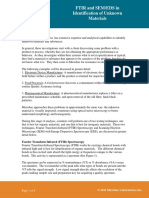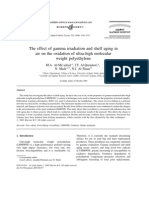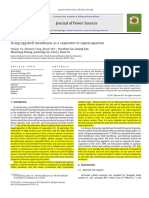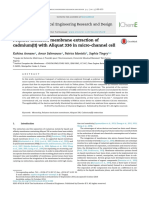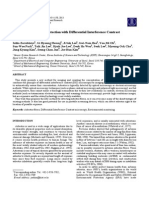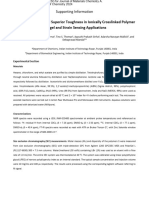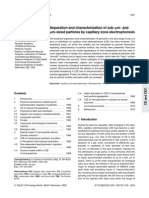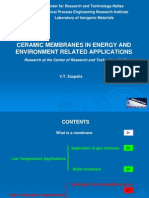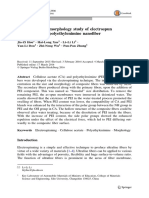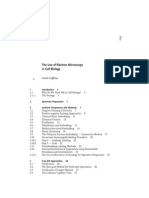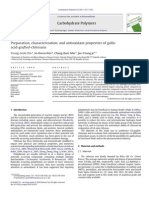In Vivo: Nanometer Size Wear Debris Generated From Ultra High Molecular Weight Polyethylene
In Vivo: Nanometer Size Wear Debris Generated From Ultra High Molecular Weight Polyethylene
Uploaded by
José santanaCopyright:
Available Formats
In Vivo: Nanometer Size Wear Debris Generated From Ultra High Molecular Weight Polyethylene
In Vivo: Nanometer Size Wear Debris Generated From Ultra High Molecular Weight Polyethylene
Uploaded by
José santanaOriginal Title
Copyright
Available Formats
Share this document
Did you find this document useful?
Is this content inappropriate?
Copyright:
Available Formats
In Vivo: Nanometer Size Wear Debris Generated From Ultra High Molecular Weight Polyethylene
In Vivo: Nanometer Size Wear Debris Generated From Ultra High Molecular Weight Polyethylene
Uploaded by
José santanaCopyright:
Available Formats
Wear 266 (2009) 349355
Contents lists available at ScienceDirect
Wear
journal homepage: www.elsevier.com/locate/wear
Short communication
Nanometer size wear debris generated from ultra high molecular weight
polyethylene in vivo
Monika Lapcikova
a
, Miroslav Slouf
a,
, Jiri Dybal
a
, Eva Zolotarevova
b
, Gustav Entlicher
b
,
David Pokorny
c
, Jiri Gallo
d
, Antonin Sosna
c
a
Institute of Macromolecular Chemistry, Academy of Sciences of the Czech Republic, v.v.i., Heyrovskeho namesti 2, 162 06 Prague 6, Czech Republic
b
Faculty of Sciences, Charles University, Hlavova 8, 12840 Prague 2, Czech Republic
c
Orthopaedics Clinic, Faculty Hospital Motol, V Uvalu 84, 156 06 Prague 5, Czech Republic
d
Department of Orthopaedics, Faculty of Medicine and Dentistry, Palacky University, I.P. Pavlova 6, 775 20 Olomouc, Czech Republic
a r t i c l e i n f o
Article history:
Received 20 December 2007
Received in revised form 21 May 2008
Accepted 9 June 2008
Available online 17 July 2008
Keywords:
Ultra high molecular weight polyethylene
Nanometer size wear debris
Morphology of wear particles
Total hip replacement
1. Introduction
a b s t r a c t
Ultra high molecular weight polyethylene ( UHMWPE) wear debris is a major cause of long-term failure
of total hip replacements. UHMWPE wear particle sizes range from submicron to several millimeters, but
the particles below 10 m exhibit the highest biological activity. Some in vitro wear particles, produced
in joint simulators, were shown to be smaller than 0.2 m and recently even in vitro particles as small as
several tens of nanometers have been detected. This study brings the rst evidence that nano-sized wear
particles wi t h sizes below 0. 05 m are produced in vivo. UHMWPE wear nanoparticles were revealed by
high-resolution, el d emission gun scanning electron microscopy (FEGSEM) in the periprosthetic tissues
of two different patients. Purity of the isolated wear nanoparticles was conrmed by energy-dispersive
analysis of X-rays (EDS) and infrared spectroscopy (IR). Morphology of wear nanoparticles was determined
by image analysis of FEGSEM micrographs. The average equivalent diameters of wear particles in the rst
and the second patient were 18.5 and 21.2 nm, respectively. Nanoscale wear debris could only be reliably
detected if the isolation protocol included intensive sonication and if higher-than-usual magni cati ons
were employed during FEGSEM analysis.
2008 Elsevier B.V. All rights reserved.
thus the most dangerous wear particles have sizes below 10 m
[8]. A few years ago in vitro experiments on wear testing machines
Ultra high molecular weight polyethylene (UHMWPE) has been
used as a bearing material in total joint replacements (TJR) for
more than four decades. The success of UHMWPE in TJRs is due
to its excellent bulk biocompatibility, very good friction proper-
ties, sufcient mechanical performance and high wear resistance
[1]. Therefore, UHMWPE is regarded as the gold standard for given
application [2,3]. Nevertheless, articulation between polymer and
metallic/ceramic components of TJR leads to generation of tiny
UHMWPE wear particles, which are released from the joint space
and cause complex inammatory reactions leading to osteolysis
and aseptic loosening [4].
Since UHMWPE wear particles were recognized as one of the
major causes of TJR failures, a number of studies describing their
isolation [5], characterization [6] and biological activity [7] have
been published. The particle sizes range from submicron to sev-
eral millimeters. It was shown that the most biologically active and
Corresponding author. Tel.: +420 296809310; fax: +420 296809410.
E-mail address: slouf@imc.cas.cz (M. Slouf).
0043-1648/$ see front matter 2008 Elsevier B.V. All rights reserved.
doi:10.1016/j.wear.2008.06.005
proved that a signicant fraction of wear particles can be smaller
than 0.2 m [9]. Recently in vitro wear particles of nanometer sizes
below 0.1 m were observed [10]. The present study proves, for the
rst time, that nanometer-sized wear particles are also generated
in vivo.
In our previous work, we focused on development of a reli-
able technique for sampling, isolation and quantication of in vivo
UHMWPE wear particles in periprosthetic tissues [1115]. More
than 100 samples of periprosthetic tissues have been processed
and both total amount and morphology of wear particles were
determined. In two cases we found that the periprosthetic tissues
contained mostly nanometer-sized wear debris.
2. Materials and methods
2.1. Isolation of wear particles
2.1.1. Sampling
UHMWPE wear particles were detected in periprosthetic (gran-
uloma) tissues obtained during revisions of TJRs in Orthopaedics
350 M. Lapcikova et al. / Wear 266 (2009) 349355
Table 1
Particle separation on low-concentration membranes was further
Summary of periprosthetic tissues studied in this work
improved by sonication as documented below.
Patient Sex Birth Weight (kg) Implant duration (years) Implant type
H1 M 1937 82 8.5 Balgrist/CF 30 2.2. Characterization of wear particles
H2 M 1957 70 8.8 ABG
2.2.1. Field-emission gun scanning electron microscopy (FEGSEM)
Clinic, Faculty Hospital Motol, Prague, Czech Republic and in the
Orthopaedic Clinic of Faculty Hospital Olomouc, Czech Republic. A
summary of periprosthetic tissues analyzed in this study is given
in Table 1.
High-resolution scanning electron microscope Quanta 200 FEG
(FEI), equipped with a eld-emission gun, was used to visual-
ize wear debris. Polycarbonate (PC) membranes with isolated
polyethylene (PE) wear particles were xed onto metallic sup-
port with a conductive silver paste, and the specimen was sputter
coated with a 10-nm thick platinum layer using a vacuum sput-
2.1.2. Purication of chemicals ter coater SCD 050 (Balzers). This xation was found necessary
Distilled water and isopropyl alcohol (iPrOH) were puried to eliminate sample drift and sample damage under the electron
before use by successive ltration through 10 and 0.1 m poly- beam at very high magnications, which were necessary to detect
carbonate (PC) Isopore membranes (Millipore, Ireland). More polyethylene nanoparticles. The micrographs were obtained with
aggressive chemicals, such as 65% HNO3 and 12 mol/l KOH were l - a secondary electron detector at an accelerating voltage of 10 kV
tered through 10 and 0.1 m Teon (PTFE) Omnipore membranes and the smallest possible spot size. In the rst step, homogeneity
(Millipore, Ireland). of PE wear particles on each PC membrane was investigated at low
magnications (500 to 5000). In the second step, selected rep-
2.1.3. Delipidation of samples
Typically, 0.3 g of a freeze-dried tissue sample was cut into small
pieces and extracted twice with 10 ml of a chloroform/methanol
resentative locations on the lters were analyzed at three different
magnications: medium magnication (7500), high magnica-
tion (12,000) and very high magnication (50, 000). In this paper
mixture (2:1, v/v) for 12 h. The solvents were decanted. After two
we use exclusively the above three magnications (medium, high
decantations the tissue samples were dried in a stream of ltered
and very high) for sake of simplicity and easy comparison of all
air and by heating for 2 h at 60
C.
samples.
2.1.4. Acid hydrolysis and washing 2.2.2. Energy-dispersive analysis of X-rays (EDS)
The delipidated samples of tissue (obtained from 0.3 g of freeze- The same samples as those used for SEM were observed in the
dried sample) were hydrolyzed with 5 ml of 65% HNO3 at room
microscope Quanta 200 FEG as described in the previous section,
temperature for 24 h. Only the upper 2 ml layer of the suspen- using an EDS detector (EDAX). EDS spectra were taken at 30 kV. The
sion was used for further isolation. The remaining lower part was signal was collected both from the whole areas of SEM micrographs
removed by aspiration and discarded. The upper layer was washed and from selected places containing large agglomerates of wear
twice with 5 ml of 65% HNO3 and twice with 5 ml of distilled
particles.
water: 5 ml of solvent (HNO3 or H2O) were added, the sample was
centrifuged (500 g, 1 min) and the lower 5 ml were removed by 2.2.3. Fourier-transform infrared spectroscopy (FTIR)
aspiration. The resulting washed 2 ml layer was neutralized with
Infrared-spectra were recorded with an IFS-55 spec-
12 mol/l KOH and washed twice with water in the same way as
trometer (Bruker, Germany) equipped with MCT detector
described above. The nal 2 ml of the sample was used for further
(256 scan/spectrum, resolution 4 cm
1
). IR spectra of selected
purication.
PC membranes with PE particles were measured before sputtering
with platinum and investigation by SEM and EDS. The measure-
2.1.5. Separation of wear debris by ltration ment was performed in two ways: (i) several locations on each
The wear debris suspension obtained by acid hydrolysis was membrane were measured by the attenuated total reection (ATR)
mixed with 2 ml of iPrOH and ltered through a 10- m Teon mem- technique using a Golden Gate TM Heated Diamond ATR Top-Plate
brane Omnipore (Millipore, USA). The ltrate was ll ed up to 6 ml (Specac Ltd.) and (ii) the whole membrane was also measured in
with iPrOH. Then these 6 ml of the suspension were divided into the transmission mode.
four parts: (i) 4.5 ml of the suspension was ltered through a 0.1-
m polycarbonate membrane Isopore (Millipore, USA), (ii) 0.2 ml of
2.2.4. Image analysis of FEGSEM micrographs
the suspension was ltered through another 0.1- m polycarbonate
Image analysis of FEGSEM micrographs was performed using
membrane Isopore (Millipore, USA), (iii) another 0.2 ml of the sus-
the Lucia program (Laboratory Imaging, Czech Republic). FEGSEM
pension was sonicated (5 min, 30 kHz, amplitude 112 m, energy
density 125 W/cm
2
) just before the ltrati on through the 0.1 m
micrographs with magnications of 50,000 were used to
distinguish and measure individual wear nanoparticles. Lower
membrane Isopore and (iv) the remaining 1.5 ml of the suspension
magnication micrographs were not used because the two ana-
was left as a reserve.
lyzed samples contained only nanoparticles, as demonstrated
below. Both image analyses were based on more than 500 particles.
2.1.6. Usage of lter membranes containing wear particles The particles were described by means of equivalent circle diam-
All membranes were investigated by all the methods described eter (D), circularity (C) and elongation (E). Equivalent diameter of
below, however, the image analysis results were based exclusively an object is equal to the diameter of a circle with the same area as
on membranes with lower concentrations of particles (0.2 ml of the corresponding object: D=(4 Area/ )
1/2
. Circularity is calcu-
the suspension), whereas infrared spectroscopy and microanalysis lated from the object area and perimeter: C =4 Area/Perimeter
2
;
were performed on all the membranes (both 0.2 and 4.5 ml). The C =1 for circles and C <1 for all other shapes. Elongation is dened
low-concentration membranes showed better particle separation as the ratio of maximum and minimum diameter of the parti-
on electron micrographs, while the high-concentration membranes cle: E =MaxDiameter/MinDiameter; E =1 for circles and E >1 for all
gave higher signals in infrared spectroscopy and microanalysis. other shapes.
M. Lapcikova et al. / Wear 266 (2009) 349355 351
particles (Al, Zr), were found; a typical EDS spectrum is shown in
Fig. 2.
3.2. Separation of nanoparticles by sonication
Fig. 3 shows PC membranes with PE particles isolated from
periprosthetic tissue of the rst patient H1 (Table 1). On the mem-
branes, nanometer-sized wear particles tended to form aggregates
(Fig. 3a, c and e), which could be disintegrated by sonication
of the ltered suspension (Fig. 3b, d and f). The aggregates of
non-sonicated nanoparticles at medium magnications (Fig. 3a;
magnication 7500) and high magnications (Fig. 3c; magni-
cation 12,000) looked as if they were microparticles. Single
nanoparticles within the aggregates were only revealed at very
high magnications (Fig. 3e; magnication 50, 000). Sonication
resulted in nanoparticle separation, which could be observed even
Fig. 1. Comparison of IR spectra of pure PE (from a catalog), blank PC mem-
brane and PC membrane with isolated PE particles. The spectra were measured in
ATR mode (PE = polyethylene, PC = polycarbonate, ATR = attenuated total reection
infrared spectroscopy).
3. Results
3.1. Purity of isolated particles
Three facts indicated that observed nanoparticles were not
artifacts, but pure UHMWPE. Firstly, we used a well-established
isolation technique, which had already been employed and per-
fected in our previous studies [1215]. Secondly, the purity of the
isolated PE particles on PC membranes was investigated by means
of FTIR: comparison of IR spectra of pure PE, unused PC mem-
brane and PC membrane with PE nanoparticles showed that all
samples exhibited only peaks of PE and/or PC (Fig. 1). Thirdly, we
performed EDS analysis of all membranes, which were investi-
gated by FEGSEM. In all cases, we found only peaks of C (mostly
from PC membrane and partially from PE particles), O (from PC
membrane), Pt (10 nm thick platinum layer from vacuum sput-
ter coater), Ag and Cl (from conductive silver paste that xed the
membranes to the support). No traces of other elements, which
would indicate bone fragments (Ca, P), dust (Si), organic impu-
rities (N, S), metallic wear particles (Cr, Mo, Ti) or ceramic wear
Fig. 2. EDS spectrum of UHMWPE wear particles on a PC membrane. The peaks of
C and O come from the PC membrane and/or UHMWPE particles. The peaks of Pt,
Ag and Cl result from the fact that the membrane was sputter coated with platinum
and xed with a conductive silver paste containing chlorine before investigation
in an electron microscope (PC = polycarbonate, EDS = energy-dispersive analysis of
X-rays).
at medium magnications (Fig. 3b). At high magnications (Fig. 3d),
the single nanoparticles could be clearly resolved. The micrographs
of sonicated nanoparticles at very high magnications (Fig. 3f) were
suitable for image analysis.
3.3. Image analysis of separated nanoparticles
Fig. 4 shows nal FEGSEM micrographs of PC membranes with
in vivo PE wear particles, which were isolated from periprosthetic
tissues of both patients (Table 1). Both suspensions of the isolated
particles were sonicated immediately before ltrati on through the
membrane to separate particles. It is worth noting that FEGSEM
micrographs displayed neither bigger particles (>0.1 m) nor impu-
rities (such as bone fragments with their characteristic texture or
dust particles with sharp edges).
Image analysis of the wear particles of each patient was based
on nine FEGSEM micrographs from different parts of the mem-
brane. All nine micrographs in each set have the same magnication
(50, 000; the same as in Fig. 4e and f) and each set of micrographs
contained more than 700 well-separated particles for analysis. The
wear particles from patients H1 and H2 exhibited average sizes
18.5 and 21.2 nm, respectively. Complete histograms (Fig. 5) proved
that in both cases the wear particles were quite small, with rel-
atively narrow size distributions. Complete numerical results of
image analysis (Table 2) re-conrmed the small particle size, con-
rmed narrow size distributions and indicated that all particles
were spherical in shape.
3.4. Nanoparticles in other samples
In the previous sections we have demonstrated that 2 samples
out of 100 contained mostly nanoparticles. Detailed microscopic
analysis of the two samples suggested that they contained
almost no microparticles. At higher magnications, practically all
microparticles were identied as the agglomerates of nanoparticles
as documented by FEGSEM (Figs. 3 and 4) and conrmed by image
analysis (Fig. 5 and Table 2).
The other samples exhibited no exceptional features and con-
tained mostly microparticles, in agreement with numerous previous
studies (e.g. [1120]). Particles coming from one of our typical
samples of periprosthetic tissue are shown in Fig. 6. The differ-
ence between the two samples containing mostly nanoparticles
(Figs. 3 and 4) and the typical samples containing mostly micropar-
ticles (Fig. 6) was visible even at medium magnication FEGSEM
micrographs (cf. Figs. 3a and b, 4a and b and 6a). In the two
samples containing nanoparticles there were no particles >0.1 m,
whereas a typical sample contained a number of particles with
dimensions >1 m. This was the main reason why we focused
our attention on the two exceptional samples and revealed wear
352 M. Lapcikova et al. / Wear 266 (2009) 349355
Fig. 3. FEGSEM micrographs of UHMWPE wear particles on 0.1 m PC membrane. All particles come from patient H1 in Table 1. Left column (a, c and e): particles without
sonication before l trati on; right column (b, d and f): particles with sonication before ltration. The selected micrographs were taken at medium (a and b), high (c and d)
and very high (e and f) magnication.
nanoparticles, which become clearly visible at higher magnica- 4. Discussion
tions (Figs. 3cf and 4cf).
Nevertheless, further analysis of the other samples, which con- In the previous section it has been demonstrated for the rst
tained mostly microparticles, showed certain small amounts of time that UHMWPE wear nanoparticles are generated in vivo. We
wear nanoparticles as well (Fig. 6b and c). Although FEGSEM should re-emphasize that in this study the term wear nanopar-
micrographs of typical samples re-conrmed clear predominance ticles denotes UHMWPE particles with sizes below 0.05 m, i.e.
of wear microparticles, small amounts of wear nanoparticles the particles whose size is even smaller than the lowest pore
could be detected (Fig. 6c), nanoparticles marked with white size in commonly used lters [9]. Three independent methods,
arrows. This indicated that a certain number of wear nanopar- FEGSEM, EDS and IR suggested that the observed nanoparticles
ticles might be present in all periprosthetic tissues. Accurate are a polyethylene and not an artifact. Moreover, the nanoparticles
determination of volume fraction of wear nanoparticles in typi- with average sizes 18.5 and 21.2 nm were observed in two indepen-
cal samples of periprosthetic tissues is a subject of our subsequent dent samples. On the other hand, many previous studies reported
study. much larger average sizes of in vivo UHMWPE wear nanoparticles.
M. Lapcikova et al. / Wear 266 (2009) 349355 353
Fig. 4. Final FEGSEM micrographs of PC membranes with UHMWPE wear particles of both studied patients, H1 and H2 (Table 1). Left column (a, c and e): particles from H1;
right column (b, d and f): particles from H2. The selected micrographs were taken at medium (a and b), high (c and d) and very high (e and f) magnications.
Why were similar wear nanoparticles not found in previous
works?
The rst reason why wear nanoparticles were not reported
before might consist in the fact that we investigated more than
100 samples and detected signicant volumes of wear nanopar-
ticles just in 2 of them. In the other samples the microparticles
predominated and the amounts of nanoparticles were either
small or negligible. Elck et al. [16] summarized the average
sizes of in vivo wear particles from various studies; their sizes
varied around 0.5 m. Also in vitro wear particles from joint
simulators showed average sizes of several tenths of microm-
eters [17]. Thus it seems that standard wear particles are
microparticles, whereas wear nanoparticles might be an excep-
tion.
The second reason why wear nanoparticles escaped the atten-
tion of previous investigators could be sonication. Wear particles
are usually isolated from periprosthetic tissues by means of
acid/base digestion method. Then the suspension of the particles
is ltered through a membrane and the particles are analyzed by
means of scanning electron microscopy. Our results showed that
the nanoparticles on the membrane tend to form agglomerates
looking like single microparticles (Fig. 3). Intensive sonication of
the suspension just before its l trati on through a membrane is nec-
essary to achieve nanoparticle separation. As this sonication was
not always used in other studies, the agglomerates of nanoparticles
could have been misinterpreted as single microparticles in partic-
ular at low and medium magnication micrographs. In this study
the nanoparticles on the membranes occurred as loose agglomer-
mated
standard
deviation
(
=
(1/n
i ( xi) ), where xi is the ith element
354 M. Lapcikova et al. / Wear 266 (2009) 349355
The fourth reason why wear nanoparticles were not found on
the membranes after isolation might consist in the isolation and
characterization methods themselves. Over the course of time, the
methods of isolation of wear particles from periprosthetic tissues
have been gradually improved. Some of the isolation protocols
were far from perfect, as discussed in our previous work [13].
Fig. 5. Histogram showing size distributions of UHMWPE wear particles isolated
from patient H1 (full columns) and patient H2 (striped columns). Size of the particles
was described by means of equivalent diameter. Number of particles used for the
analysis was >700 in both cases.
ates (Figs. 3 and 4). If the sonication was even more intensive, the
nanoparticles might be completely separated and, consequently,
they might go through the membrane without being detected. It
seems that just sufcient sonication is needed to catch the nanopar-
ticles.
The third reason why wear nanoparticles were not observed
might be associated with a combination of sonication, high magni-
cations and the use of FEGSEM instead of standard SEM microscopy.
The effect of sonication has already been discussed in the previ-
ous paragraph. The effect of high magnication is as follows: an
ISO standard for quantitative image analysis of wear nanoparticles
[18] recommends using SEM micrographs with magnications of
at least 5000. Such medium magnications (5000 to 10,000)
were used in most of the previous studies, whereas here we
have demonstrated that non-sonicated wear nanoparticles were
observed only at very high magnications (50,000). In a standard
SEM microscope, it is possible to achieve such a high magnication
with a good signal and resolution only if an intensive electron beam
and acceleration voltage around 30 kV are used. We have veried
that under such conditions the PC membranes with PE particles
were burnt by the electron beam and, as a result, the nanoparticles
could not be observed. In a FEGSEM microscope, the magnication
50,000 with good resolution could be achieved at 10 kV and a
small probe size, which did not destroy the specimens. Therefore,
somewhat unusual combination of sonication, very high magni-
cation and FEGSEM microscopy seems to be necessary for detection
of wear nanoparticles. At the highest magnications the nanoparti-
cles could be observed even without sonication, but they were not
so well separated from each other.
Table 2
Results of the image analysis of UHMWPE nanoparticles
Patient Eq. diameter (D) Circularity (C) Elongation (E)
(nm) (nm) () () () ()
H1 18.47 5.29 0.97 0.07 1.29 0.13
H2 21.20 8.01 0.93 0.09 1.35 0.29
Each numerical value in this table was calculated from a distribution obtained by
image analysis of nine FEGSEM micrographs with magnication 50,000 and real
width 1.26 m. The mean of the distribution, , was calculated as the arithmetic
mean
(
=
1/n
i
xi
)
and
the
width
of
the
distribution,
,
was
calculated
as
esti-
2
of the distribution, n is the number of all elements in the distribution and summation
Fig. 6. FEGSEM micrographs of PC membranes with UHMWPE wear particles of a
typical patient, whose periprosthetic tissue contained mostly microparticles. The
micrographs were taken at medium (a), high (b) and very high (c) magnications.
A few nanoparticles are visible at very high magnications (marked with white
runs through all elements.
arrows).
M. Lapcikova et al. / Wear 266 (2009) 349355 355
In some other studies, the authors used techniques, which were
not able to detect the smallest particles. For example, some parti-
cle counters detected only particles with sizes above 0.3 m [19],
in transmission electron microscopy the nanoparticles might be
hardly observable due to insufcient contrast as their size may be
lower than the thickness of investigated ultrathin section (typically
around 60 nm) [20] and in the methods based on light scatter-
ing the signal from bigger particles may entirely predominate
[11,12]. Our results suggest that a combination of isolation method
(veried in previous studies) and good detection method (sonica-
tion +FEGSEM) are necessary to catch wear nanoparticles. In future
studies the in vivo UHMWPE wear nanoparticles might be observed
more and more frequently as the sampling, isolation and detection
methods are further improved.
5. Conclusion
Methods for isolation and visualization of UHMWPE wear par-
ticles are still being improved. As a result, it has been possible
to isolate and detect smaller and smaller wear particles. A few
years ago Scott et al. [9] proved that a signicant fraction of in
vitro UHMWPE wear particles can be smaller than 0.2 m. Recently
Galvin et al. [10] found in vitro UHMWPE wear nanoparticles with
sizes below 0.1 m. In the present work we found, for the rst time,
in vivo UHMWPE wear nanoparticles with sizes below 0.05 m.
These nanoparticles were isolated from periprosthetic tissues of
two different patients and had average particle size of 18.5 and
21.2 nm in the rst and the second case, respectively.
Acknowledgement
Financial support through grant 2B06096 (Ministry of Edu-
cation, Youth and Sports of the Czech Republic) is gratefully
acknowledged.
References
[1] G. Lewis, Properties of crosslinked ultra-high-molecular-weight polyethylene,
Biomaterials 22 (2001) 371401.
[2] Alternatives to conventional UHMWPE for hip arthroplasty, in: S.M. Kurtz (Ed.),
The UHMWPE Handbook, Elsevier, Amsterdam, 2004, p. 93 (Chapter 6).
[3] S.M. Kurtz (Ed.), The Clinical Performance of UHMWPE in Knee Replacements.
The UHMWPE Handbook, Elsevier, Amsterdam, 2004, p. 182 (Chapter 8).
[4] G. Lewis, Polyethylene wear in total hip and knee arthroplasties, J. Biomed.
Mater. Res. 38 (1997) 5575.
[5] J.L. Tipper, E. Ingham, J.L. Hailey, A.A. Besong, J. Fisher, B.M. Wroblewski, M.H.
Stone, Quantitative analysis of polyethylene wear debris, wear rate and head
damage in retrieved Charnley hip prostheses, J. Mater. Sci.: Mater. Med. 11
(1999) 117124.
[6] J.D. Mabrey, A. Afsar-Keshmiri, G.A. Engh, C.J. Sychterz, M.A. Wirth, C.A.
Rockwood, C.M. Agrawal, Standardized analysis of UHMWPE wear parti-
cles from failed total joint arthroplasties, J. Biomed. Mater. Res. 63 (2002)
475548.
[7] E. Ingham, J. Fisher, Proceedings of the Institution of Mechanical Engineers. Part
HJ. Eng. Med. 214 (2000) 2137.
[8] J.B. Matthews, A.A. Besong, T.R. Green, M.H. Stone, B.M. Wroblewski, J. Fisher,
E. Ingham, Evaluation of the response of primary human peripheral blood
mononuclear phagocytes to challenge with in vitro generated clinically rel-
evant UHMWPE particles of known size and dose, J. Biomed. Mater. Res. 52
(2000) 296307.
[9] M. Scott, K. Widding, S. Jani, Do current wear particle isolation procedures
underestimate the number of particles generated by prosthetic bearing com-
ponents? Wear 251 (2001) 12131217.
[10] A.L. Galvin, J.L. Tipper, E. Ingham, J. Fischer, Nanometre size wear debris gen-
erated from crosslinked and non-crosslinked ultra high molecular weight
polyethylene in articial joints, Wear 259 (2005) 977983.
[11] M. Slouf, I. Sloufova, G. Entlicher, Z. Horak, M. Krejc, P. Stepanek, T. Radonsky, D.
Pokorny, A. Sosna, New fast method for determination of numbers of UHMWPE
wear particles, J. Mater. Sci.: Mater. Med. 15 (2004) 12671278.
[12] D. Pokorny, M. Slouf, Z. Horak, D. Jahoda, G. Entlicher, S. Eklova, A. Sosna, Method
for assesment of distribution of UHMWPE wear particles in periprosthetic tis-
sues in total hip arthroplasty, Acta Chirurgiae Othopaedicae et Traumatologiae
Cechosl 73 (2006) 243250.
[13] M. Slouf, S. Eklova, J. Kumstatova, S. Berger, H. Synkova, A. Sosna, D. Poko-
rny, M. Spundova, G. Entlicher, Isolation, characterization and quantication of
polyethylene wear debris from periprosthetic tissues around total joint replace-
ments, Wear 262 (2007) 11711181.
[14] M. Slouf, D. Pokorny, G. Entlicher, J. Dybal, H. Synkova, M. Lapcikova, Z. Fej-
farkova, M. Spundova, F. Vesely, A. Sosna, Quantication of UHMWPE wear
in periprosthetic tissues of hip arthroplasty: description of a new method
based on IR and comparison with radiographic appearance, Wear 265 (2008)
674684.
[15] E. Zolotarevova, Z. Fejfarkova, G. Entlicher, M. Lapcikova, M. Slouf, D. Pokorny, A.
Sosna, Can centrifugation affect the morphology of polyethylene wear debris?
Wear (in press) doi:10.1016/j.wear.2008.04.005.
[16] A.P.D. Elck, S.M. Green, S. Krikler, A. Unsworth, The nature and dissemination
of UHMWPE wear debris retrieved from periprosthetic tissue of THR, J. Biomed.
Mater. Res. 65A (2003) 95108.
[17] O. Calonius, V. Saikko, Analysis of polyethylene particles produced in different
wear conditions in vitro, Clin. Orthop. Rel. Res. 399 (2002) 219230.
[18] ISO 17853:2003 (E).
[19] K.J. Margevicius, T.W. Bauer, J.T. McMahon, S.A. Brown, K. Merritt, Isolation and
characterization of debris in membranes around total joint prostheses, J. Bone
Joint Surg. 76-A (1994) 16641675.
[20] M. Visentin, S. Stea, S. Squarzoni, B. Antonietti, M. Reggiani, A. Toni, A new
method for isolation of polyethylene wear debris from tissue and synovial uid,
Biomaterials 25 (2004) 55315537.
You might also like
- Knauf Danoline Kraft Acoustic Plaster Ceiling SystemDocument12 pagesKnauf Danoline Kraft Acoustic Plaster Ceiling SystemKen R100% (1)
- Plasma CleaningDocument10 pagesPlasma CleaningDEEPAK KUMARNo ratings yet
- Ready To Download: Sandisk® Secureaccess™ For Mac UsersDocument1 pageReady To Download: Sandisk® Secureaccess™ For Mac UsersJosé santanaNo ratings yet
- TMP 5 D61Document7 pagesTMP 5 D61FrontiersNo ratings yet
- Oxidation of Orthopaedic UHMWPE: L. Costa, K. Jacobson, P. Bracco, E.M. Brach Del PreverDocument12 pagesOxidation of Orthopaedic UHMWPE: L. Costa, K. Jacobson, P. Bracco, E.M. Brach Del PreverJobin VargheseNo ratings yet
- Microscopic Observation of Bacteria: Review Highlighting The Use of Environmental SEMDocument14 pagesMicroscopic Observation of Bacteria: Review Highlighting The Use of Environmental SEMNurul EnieyNo ratings yet
- López-Polín, L. Et Al. Láser Removing Carbonated Matrices From Fossils. 2008Document8 pagesLópez-Polín, L. Et Al. Láser Removing Carbonated Matrices From Fossils. 2008Trinidad Pasíes Arqueología-ConservaciónNo ratings yet
- Degradation of 2,4,6-Trichlorphenol by Producing Hydrogen Using Ultrasonic Mist Generated From Photocatalysts SuspensionDocument6 pagesDegradation of 2,4,6-Trichlorphenol by Producing Hydrogen Using Ultrasonic Mist Generated From Photocatalysts SuspensionNur IzzatieNo ratings yet
- FTIR and SEMEDS in Identification of Unknown Materials97Document4 pagesFTIR and SEMEDS in Identification of Unknown Materials97saynexNo ratings yet
- Visualization of Cytoskeletal Elements by The Atomic Force MicroscopeDocument21 pagesVisualization of Cytoskeletal Elements by The Atomic Force MicroscopeBiraj KarmakarNo ratings yet
- Joy, Sep 2011Document4 pagesJoy, Sep 2011emediageNo ratings yet
- 1 s2.0 S0169433205012377 MainDocument7 pages1 s2.0 S0169433205012377 MainJobin VargheseNo ratings yet
- Using Eggshell Membrane As A Separator in Supercapacitor: Journal of Power SourcesDocument6 pagesUsing Eggshell Membrane As A Separator in Supercapacitor: Journal of Power Sourcesdeni.sttnNo ratings yet
- App of TEM SEMDocument53 pagesApp of TEM SEMDevraj Mishra100% (2)
- Molybdenum Oxide Nanocolloids PreparedDocument5 pagesMolybdenum Oxide Nanocolloids PreparedLê CôngNo ratings yet
- Leclaire Rev1Document6 pagesLeclaire Rev1mackerelfishNo ratings yet
- Bensouda 2018Document24 pagesBensouda 2018Adrian RosasNo ratings yet
- Membrana de Inclusión de Polímeros, Extracción de Cadmio (II) Con Aliquat 336 en Células de MicrocanalesDocument6 pagesMembrana de Inclusión de Polímeros, Extracción de Cadmio (II) Con Aliquat 336 en Células de MicrocanalesMaicol PérezNo ratings yet
- Book of Abstracts Posters ADocument82 pagesBook of Abstracts Posters AAlbana HasimiNo ratings yet
- Abstracts IschiaDocument81 pagesAbstracts IschiapplotticiNo ratings yet
- Yeoho Kim, Seung-Wan Jin, Hyun-Tae Kim, Tae-Gon Kim, Kyu-Hwang Won and Jin-Goo ParkDocument6 pagesYeoho Kim, Seung-Wan Jin, Hyun-Tae Kim, Tae-Gon Kim, Kyu-Hwang Won and Jin-Goo Parksumit kumarNo ratings yet
- 30 - Aaqr 12 04 Oa 0094 - 1145 1150 PDFDocument6 pages30 - Aaqr 12 04 Oa 0094 - 1145 1150 PDFMelih AltıntaşNo ratings yet
- VibspecDocument10 pagesVibspecajay nayakNo ratings yet
- Rapid Self-Healing and Superior Toughness in Ionically Crosslinked PolymerDocument18 pagesRapid Self-Healing and Superior Toughness in Ionically Crosslinked Polymersselvam222No ratings yet
- Energy-Dispersive X-Ray SpectrosDocument9 pagesEnergy-Dispersive X-Ray SpectrosJuan CogolludoNo ratings yet
- Control of Thickness of PEDOT Electrodeposits On GlassITODocument8 pagesControl of Thickness of PEDOT Electrodeposits On GlassITOGonzalo FenoyNo ratings yet
- Methods of Studying Cells 2024/2025Document6 pagesMethods of Studying Cells 2024/2025djenenenouha30No ratings yet
- Ijaret: International Journal of Advanced Research in Engineering and Technology (Ijaret)Document7 pagesIjaret: International Journal of Advanced Research in Engineering and Technology (Ijaret)IAEME PublicationNo ratings yet
- Thermal Expans and TG Fig8-9Document11 pagesThermal Expans and TG Fig8-9elvannrmnNo ratings yet
- 2019 - Van Meerbeek-Cokic2019Document12 pages2019 - Van Meerbeek-Cokic2019Mohamed FayezNo ratings yet
- Supporting Information Available:: Synthesis of The Pani Functional Mno NanocompositeDocument7 pagesSupporting Information Available:: Synthesis of The Pani Functional Mno NanocompositeM.N.ENo ratings yet
- Hetero-Nanojunctions With Atomic Size Control Using A Lab-On-Chip Electrochemical Approach With Integrated MicrofluidicsDocument14 pagesHetero-Nanojunctions With Atomic Size Control Using A Lab-On-Chip Electrochemical Approach With Integrated Microfluidicsanon_666754590No ratings yet
- Preparation and Characterization of Microfiltration Membrane Embedded With Silver Nano-ParticlesDocument7 pagesPreparation and Characterization of Microfiltration Membrane Embedded With Silver Nano-ParticlesdahliaNo ratings yet
- Electrophoresis Separation TechniqueDocument16 pagesElectrophoresis Separation Techniquesenthil347No ratings yet
- Failure Behavior of Nano-Sio Fillers Epoxy Coating Under Hydrostatic PressureDocument9 pagesFailure Behavior of Nano-Sio Fillers Epoxy Coating Under Hydrostatic Pressureeid elsayedNo ratings yet
- Composites Science and TechnologyDocument7 pagesComposites Science and TechnologyAsih RahmatNo ratings yet
- Electrospun Eri Silk Fibroin Scaffold Coated With Hydroxyapatite For Bone Tissue Engineering ApplicationsDocument11 pagesElectrospun Eri Silk Fibroin Scaffold Coated With Hydroxyapatite For Bone Tissue Engineering ApplicationsSenthil KumarNo ratings yet
- Technical Study and Field TestsDocument118 pagesTechnical Study and Field TestsaluxbalumNo ratings yet
- Fast and Low Temperature Growth of Electron Transport Layers For Efficient Perovskite Solar CellsDocument7 pagesFast and Low Temperature Growth of Electron Transport Layers For Efficient Perovskite Solar CellsHuckkey HuNo ratings yet
- Ceramic Membranes in Energy andDocument19 pagesCeramic Membranes in Energy andXiaoqin ZouNo ratings yet
- Research Highlights: Silk Foam Waveguides Phase-Change ControlDocument1 pageResearch Highlights: Silk Foam Waveguides Phase-Change Control守安相太No ratings yet
- Fabrication and Morphology Study of Electrospun Cellulose Acetate/polyethylenimine NanofiberDocument18 pagesFabrication and Morphology Study of Electrospun Cellulose Acetate/polyethylenimine Nanofiberomeraijaz599No ratings yet
- Effect of Oxide Nanoparticles On Thermal and Mechanical Properties Ofelectrospun Separators For Lithium-Ion BatteriesDocument10 pagesEffect of Oxide Nanoparticles On Thermal and Mechanical Properties Ofelectrospun Separators For Lithium-Ion BatteriesTamam AbymNo ratings yet
- ID4656 Goethals PaperDocument7 pagesID4656 Goethals PaperAnnelies GoethalsNo ratings yet
- 1 s2.0 S0167577X20311319 MainDocument3 pages1 s2.0 S0167577X20311319 MainJenny ZingapanNo ratings yet
- SAJETModel PaperDocument13 pagesSAJETModel PaperDharma LingamNo ratings yet
- Coblation in ENT PDFDocument45 pagesCoblation in ENT PDFLoredana Albert CujbaNo ratings yet
- Mazzei 2002Document12 pagesMazzei 2002Tú NguyễnNo ratings yet
- Correlative Analysis of The Crystallization of Sol-Gel Dense and Mesoporous Anatase Titania FilmsDocument7 pagesCorrelative Analysis of The Crystallization of Sol-Gel Dense and Mesoporous Anatase Titania FilmsStefanoEnzoNo ratings yet
- Zeolite Modified Gas Sensors For Environmental Monitoring: A. Afonja, I.P. Parkin, R. BinionsDocument4 pagesZeolite Modified Gas Sensors For Environmental Monitoring: A. Afonja, I.P. Parkin, R. Binionsgomgom112No ratings yet
- Artificial Ageing of Thin Films of The Indium-FreeDocument24 pagesArtificial Ageing of Thin Films of The Indium-Freekesava76No ratings yet
- Sugar and Ice - Immunoelectron Microscopy Using Cryosections According To The Tokuyasu MethodDocument13 pagesSugar and Ice - Immunoelectron Microscopy Using Cryosections According To The Tokuyasu MethodUNIG Aluana SantanaNo ratings yet
- Electron Microscopy in Cell BiologyDocument68 pagesElectron Microscopy in Cell BiologyDouglasCastroNo ratings yet
- Polymers 11 01272 PDFDocument19 pagesPolymers 11 01272 PDFkajol agarwalNo ratings yet
- Research Article: Comparison of Nondestructive Testing Methods On Detection of Delaminations in CompositesDocument8 pagesResearch Article: Comparison of Nondestructive Testing Methods On Detection of Delaminations in CompositesFofaSistaNo ratings yet
- Foods Under The MicroscopeDocument35 pagesFoods Under The MicroscopesnkalipsoNo ratings yet
- Effect of Porosity On The Absorbed, Reemitted and Transmitted Light by A Geopolymer Metakaolin BaseDocument4 pagesEffect of Porosity On The Absorbed, Reemitted and Transmitted Light by A Geopolymer Metakaolin BasekhoagleNo ratings yet
- Chapter 8 - Correlative Cryo Fluorescence and Cryo Soft X R - 2014 - Methods inDocument28 pagesChapter 8 - Correlative Cryo Fluorescence and Cryo Soft X R - 2014 - Methods inAJ BoonNo ratings yet
- Eis Analysis On Low Temperature Fabrication of Tio Porous Films For Dye-Sensitized Solar CellsDocument36 pagesEis Analysis On Low Temperature Fabrication of Tio Porous Films For Dye-Sensitized Solar CellsUdai SinghNo ratings yet
- Cheung BBioel2006 Flex ElectrodesDocument8 pagesCheung BBioel2006 Flex ElectrodesmachdichbereitNo ratings yet
- New Sensors and Processing ChainFrom EverandNew Sensors and Processing ChainJean-Hugh ThomasNo ratings yet
- W13018-YT01-GDF-457110 Rev 5-APVDocument8 pagesW13018-YT01-GDF-457110 Rev 5-APVJosé santanaNo ratings yet
- Validation of Particle Flow Through A Conveyor Transfer Hood Via Particle Velocity AnalysisDocument6 pagesValidation of Particle Flow Through A Conveyor Transfer Hood Via Particle Velocity AnalysisJosé santanaNo ratings yet
- The Prediction of Conveyor Trajectories: DB Hastie and PW WypychDocument17 pagesThe Prediction of Conveyor Trajectories: DB Hastie and PW WypychJosé santanaNo ratings yet
- Analytical and Numerical Investigations Into Belt Conveyor TransfersDocument34 pagesAnalytical and Numerical Investigations Into Belt Conveyor TransfersJosé santanaNo ratings yet
- The Profile of Conveyor TrajectoriesDocument11 pagesThe Profile of Conveyor TrajectoriesJosé santanaNo ratings yet
- The Prediction of Conveyor Trajectories: DB Hastie and PW WypychDocument17 pagesThe Prediction of Conveyor Trajectories: DB Hastie and PW WypychJosé santanaNo ratings yet
- Luis 48Document7 pagesLuis 48José santanaNo ratings yet
- Conveyor Trajectory Discharge AnglesDocument10 pagesConveyor Trajectory Discharge AnglesJosé santanaNo ratings yet
- Modelling and Design of Complete Conveyor Transfers: D.B. Hastie, A.P. Grima and P.W. WypychDocument20 pagesModelling and Design of Complete Conveyor Transfers: D.B. Hastie, A.P. Grima and P.W. WypychJosé santanaNo ratings yet
- Belt Conveyors: Mechanical Engineering Department Carlos III UniversityDocument19 pagesBelt Conveyors: Mechanical Engineering Department Carlos III UniversityJosé santanaNo ratings yet
- Polyethylene Particles From A Hip Simulator Cause Ca Release From Cultured BoneDocument8 pagesPolyethylene Particles From A Hip Simulator Cause Ca Release From Cultured BoneJosé santanaNo ratings yet
- Design of A Hip Joint Simulator According To The ISO 14242: Nikolaos I. Galanis, Member, IAENG and Dimitrios E. ManolakosDocument6 pagesDesign of A Hip Joint Simulator According To The ISO 14242: Nikolaos I. Galanis, Member, IAENG and Dimitrios E. ManolakosJosé santanaNo ratings yet
- A Hip Wear Simulator With 100 Test StationsDocument10 pagesA Hip Wear Simulator With 100 Test StationsJosé santanaNo ratings yet
- The Effect of Counterface Roughness On The Wear of UHMWPE For Rectangular Wear PathsDocument8 pagesThe Effect of Counterface Roughness On The Wear of UHMWPE For Rectangular Wear PathsJosé santanaNo ratings yet
- What Is The Role of Wear Testing and Joint Simulator Studies in Discriminating Among Materials and Designs?Document9 pagesWhat Is The Role of Wear Testing and Joint Simulator Studies in Discriminating Among Materials and Designs?José santanaNo ratings yet
- PINO DISCO Influence OfcrosslinkedpolyethylenestructureonwearofjointreplacementsDocument13 pagesPINO DISCO Influence OfcrosslinkedpolyethylenestructureonwearofjointreplacementsJosé santanaNo ratings yet
- Can Centrifugation Affect The Morphology of Polyethylene Wear Debris?Document4 pagesCan Centrifugation Affect The Morphology of Polyethylene Wear Debris?José santanaNo ratings yet
- A Unified Theory of Wear For Ultra-High Molecular Weight Polyethylene in Multi-Directional SlidingDocument10 pagesA Unified Theory of Wear For Ultra-High Molecular Weight Polyethylene in Multi-Directional SlidingJosé santanaNo ratings yet
- Sergio 1Document13 pagesSergio 1José santanaNo ratings yet
- Datasheet 201112Document2 pagesDatasheet 201112Andreas HaryonoNo ratings yet
- Manufacturing Pharmacy Answer Key PINK PACOPDocument22 pagesManufacturing Pharmacy Answer Key PINK PACOPprincessrhenette67% (3)
- 003 Cat-6060 SuperstructureDocument18 pages003 Cat-6060 Superstructureenrico100% (1)
- Chemistry Question Bank RKLDocument31 pagesChemistry Question Bank RKLSahil GuptaNo ratings yet
- Jasco HPLC ManualDocument40 pagesJasco HPLC ManualanangNo ratings yet
- Introduction (Electricity and Atomic Structure) STUDENTSDocument15 pagesIntroduction (Electricity and Atomic Structure) STUDENTSJose NavarroNo ratings yet
- Preparation, Characterization, and Antioxidant Properties of GallicDocument6 pagesPreparation, Characterization, and Antioxidant Properties of GallicAnonymous xGc8MRRysNo ratings yet
- Hvac Factsheet BasicsDocument3 pagesHvac Factsheet BasicsAnwar SyedNo ratings yet
- QuestionsDocument3 pagesQuestionsmonalNo ratings yet
- Fiber Rope and Wire RopeDocument20 pagesFiber Rope and Wire RopeGabrielNo ratings yet
- Practical Class Ix Science 2024-25Document12 pagesPractical Class Ix Science 2024-25kk3987237No ratings yet
- Easy PCB (Printed Circuit Board) Fabrication, Using Laser Pri...Document18 pagesEasy PCB (Printed Circuit Board) Fabrication, Using Laser Pri...Puiu BercioiuNo ratings yet
- A Astronom As EsDocument40 pagesA Astronom As EsareianoarNo ratings yet
- Hot Mix Asphalt Plant Operations PDFDocument81 pagesHot Mix Asphalt Plant Operations PDFMehaboob Basha100% (1)
- The Iron-Iron Carbide Equilibrium DiagramDocument15 pagesThe Iron-Iron Carbide Equilibrium DiagramjhangeerNo ratings yet
- D 6968 PDFDocument8 pagesD 6968 PDFyuliaNo ratings yet
- KS5 Chemistry OCR A Curriculum Map 2022Document4 pagesKS5 Chemistry OCR A Curriculum Map 2022ghbydcqyf2No ratings yet
- Solenoid Valve 2/2 Way N.C. Combined Operation: PresentationDocument2 pagesSolenoid Valve 2/2 Way N.C. Combined Operation: PresentationAnonymous E7fGC1No ratings yet
- Fire Investigation ReportDocument7 pagesFire Investigation ReportTenson ChikumbaNo ratings yet
- Lopez-Toledo - Heat and Mass Transfer Characteristics of A WipedDocument224 pagesLopez-Toledo - Heat and Mass Transfer Characteristics of A WipedNatrix2No ratings yet
- Edward D. Palik - Handbook of Optical Constants of SolidsDocument337 pagesEdward D. Palik - Handbook of Optical Constants of SolidsAaron Chacaliaza RicaldiNo ratings yet
- 01 Energetics Notes 2022Document34 pages01 Energetics Notes 2022Waniya FaisalNo ratings yet
- Guardian: Portable Filtration SystemDocument8 pagesGuardian: Portable Filtration SystemmorenomorneoNo ratings yet
- Lectures 2-3 (v1.1) PDFDocument130 pagesLectures 2-3 (v1.1) PDFJordan ThomsonNo ratings yet
- Vocational Training Report, Indian Oil Corporation Limited, Gujarat RefineryDocument43 pagesVocational Training Report, Indian Oil Corporation Limited, Gujarat Refineryjhashashank26883% (12)
- KGC - Company Profile Pulp and PaperDocument30 pagesKGC - Company Profile Pulp and PaperLuan NguyenNo ratings yet
- Technical Data Sheet Chemitac 11: DescriptionDocument3 pagesTechnical Data Sheet Chemitac 11: DescriptionPhuong The NguyenNo ratings yet
- Wound Healing Activity of Aloe Vera Extract SprayDocument11 pagesWound Healing Activity of Aloe Vera Extract SprayNofi Lutfiah SfaNo ratings yet
- Corrosion Science: Pengpeng Bai, Shuqi Zheng, Hui Zhao, Yu Ding, Jian Wu, Changfeng ChenDocument10 pagesCorrosion Science: Pengpeng Bai, Shuqi Zheng, Hui Zhao, Yu Ding, Jian Wu, Changfeng ChenArturo CervantesNo ratings yet








